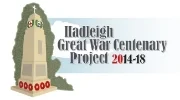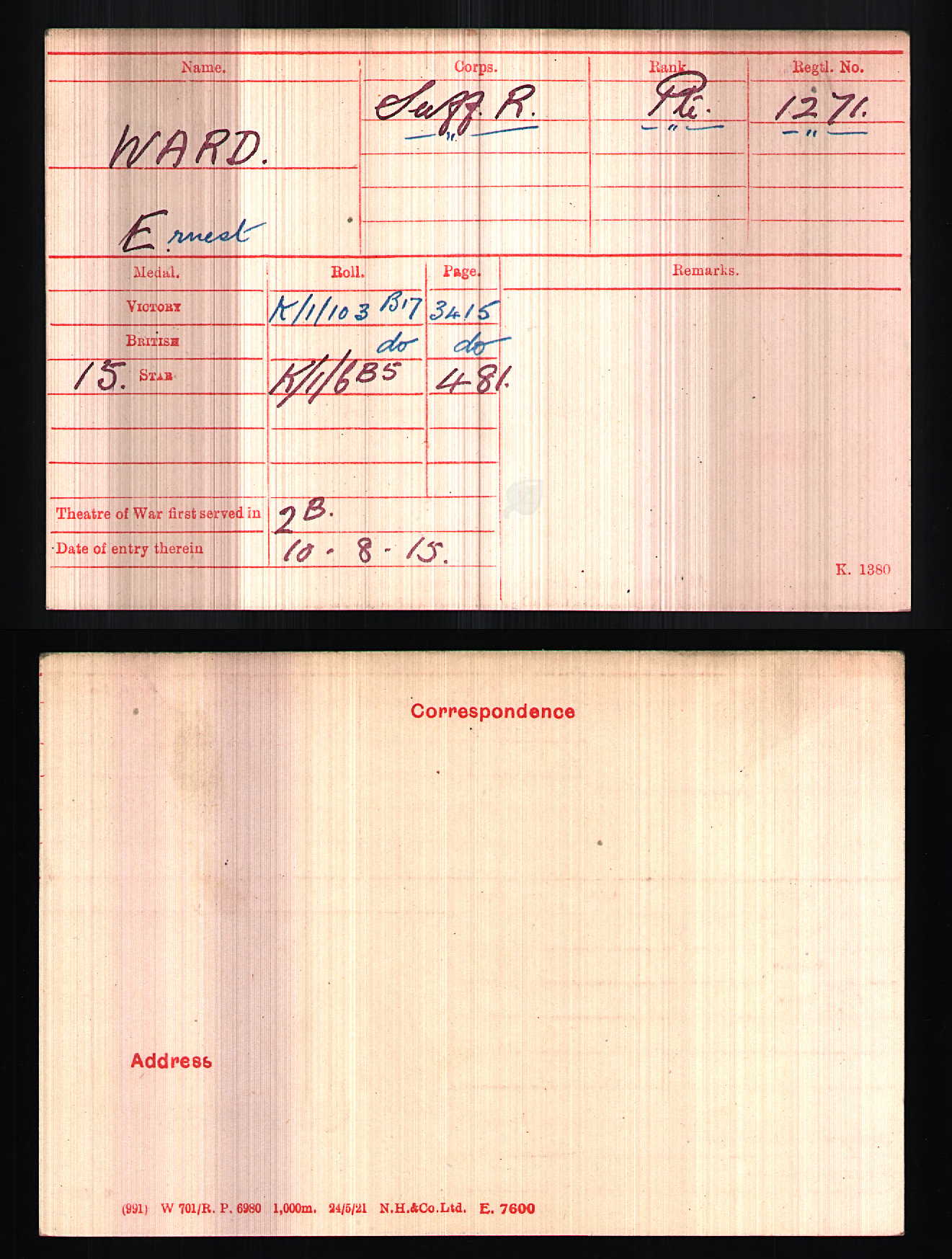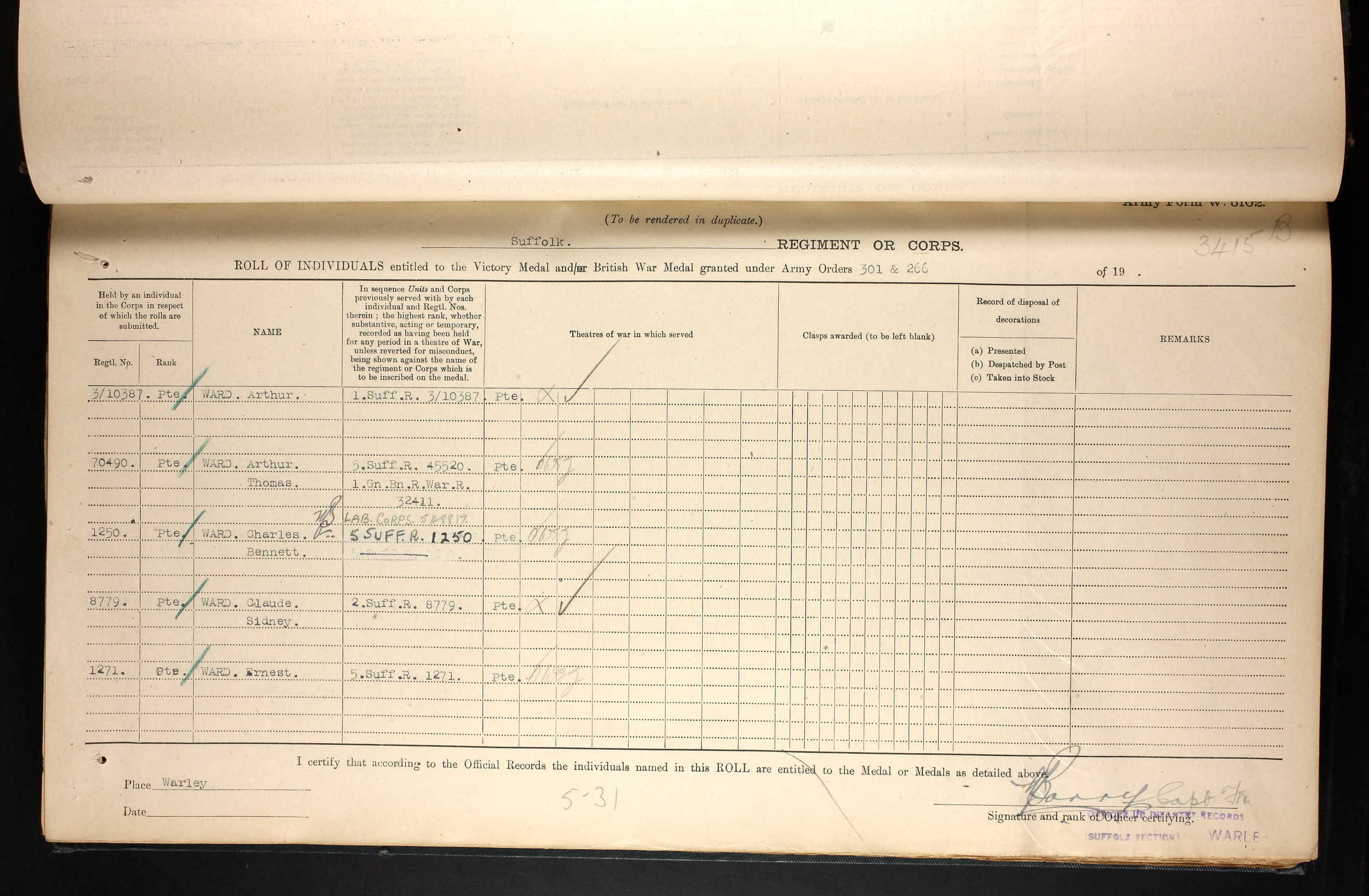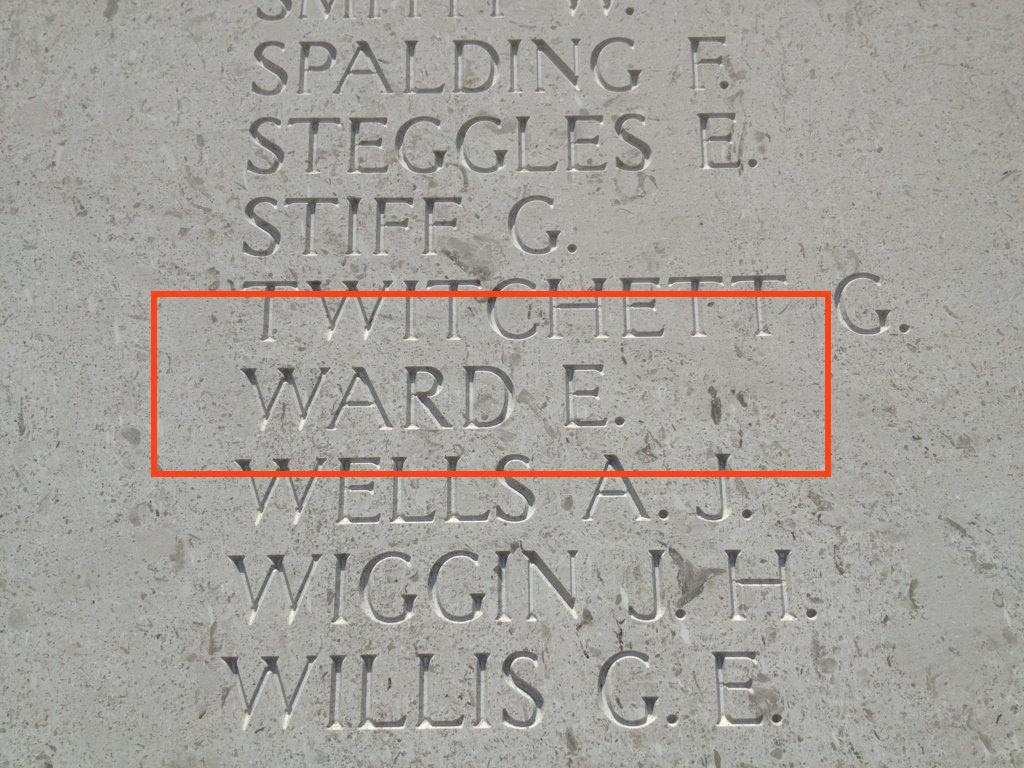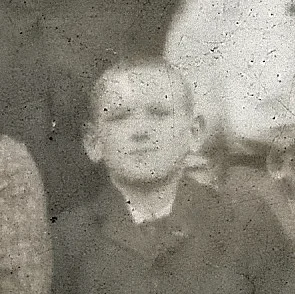Ernest Reginald Joe Ward
Rank: Private
Service Number: 1271
Date of Birth: 1896
Regiment: A Coy, 1/5th Suffolk Regiment
Date of Death: 12 Aug 1915
Age at death: 19
Cemetery / Memorial: Helles Memorial
Country: Gallipoli, Turkey
Grave / Reference: Panel 46 and 47
Relatives: Son on Hannah Maria Ward
Address: 1 Gallows Hill, Hadleigh
Ernest was born in Hadleigh in 1896. The 1901 Census report him as living at home with his parents John and Hannah Maria and his siblings; John A (15), Henry W (13), Robert G (10), Frederick (8) and Kathleen (1) at 1Gallows Hill, Hadleigh. By 1911, older brothers John, Henry and Robert have all left home. John had married Alice Carter and moved to 5 Calais Street and Henry and Robert had both joined the Army. In 1911 Ernest was working as a fishmonger's assistant.
Private Ernest Ward
The family photo below was taken in October 1909 when Ernest was 13 years old. He is the young chap sat on the right on the front row. By the time war breaks out, this family have four sons serving in the Army. Henry Ward (rear, second from left) joined the 16th Lancers in 1908. He married Alice Finch (standing on his right, rear, left) in 1911. He went to France with his unit on 17 August 1914. He survived the war and re-enlisted into the 10th Hussars in 1918. He was awarded the Long Service and Good Conduct (LS&GC) medal in 1926. He was still in Army 1928. He died Totnes, Devon in 1967. Alice died in 1916. At the time Henry was granted compassionate leave but could not get home before the funeral. He remarried 1921 to Ester Stillwell.
Robert Ward (rear, centre) joined the Grenadier Guards in 1908. His unit were also one of the first to arrive in France after the outbreak of war. Robert saw a lot of action and was awarded the Military Medal for Gallantry. During his time overseas he was a frequent letter writer and used to correspond with his old headmaster at the Hadleigh Boys School, Mr Hariss, who would publish excerpts from the letters in the local press. Sadly, Robert was killed during the war and you can read his story on this website.
Frederick Ward (Rear, 5th from left) enlisted into the 5th Suffolks in August 1914 and went to Gallipoli with them the following July. He was evacuated on the 17 August 1915 suffering from shell shock. He was no doubt a casualty of the 12 August advance. He later re-joined battalion and later transferred to Machine Gun Corps on 10 August 1916. He served in Gaza and Palestine. He was wounded on several occasions and suffered severe attacks of dysentery. He married in 1919 and died Samford Dist. 1974.
Given his age and regimental number, we believe that Ernest enlisted into the 5th Suffolks in 1911 when he was only 16 years old. Service with the local territorial battalion was appealing to some young men as it offered a taste of adventure, camaraderie and best of all a free two-week summer camp each year. If we assume that Ernest had joined the battalion before war broke out then we know that he would have been mobilised on the night of the 4th/5th August 1914.
Once mobilised the 1st/5th Suffolks spent a number of months carrying out home service tasks. At that time territorial units were liable for home service only and were not required to deploy overseas. However, when it became apparent that more troops would be needed for overseas service, the men of the battalion were asked to volunteer. After giving this some serious thought, 72% of the men volunteered and the battalion was redesigned 1st/5th Suffolk Regiment. Those who opted to stay on home service duties only, became the 2nd/5th Suffolks.
The 1st/5th Suffolks completed their training and preparation and were re-equipped for service in the eastern theatre. They embarked along with the rest of 163 Brigade and the 54 Eastern Division at the end of July from Liverpool bound for Gallipoli. They arrived and went ashore at Suvla Bay on 10th August 1915 and were quickly moved forward and by midday on the 12th were manning the forward trenches on the Anafarta Plain.
The remains of a lighter, once used to ferry troops ashore at Suvla Bay
Landing beach at Suvla Bay
At 4pm they were ordered forward as part of a 163 Brigade operation to clear the Plain of snipers in preparation for a much larger Divisional operation that was planned for the following day. The battalion was on the left of the brigade line and 'A' Company made up of Hadleigh men were in the first wave. There was at least 75 Hadleigh men involved and this was a true baptism of fire. They were told it would be a straight forward advance to mop up the odd sniper, but in reality they faced a determined and ruthless enemy. The enemies intimate knowledge of the ground was key. They sniped the Suffolks who could not see the firing points and even if they could, they had no artillery support to combat the snipers. In addition, the Turks made best use of their own artillery which ultimately halted the brigades advance. The Suffolks fell back to a shallow river bed / ditch where they formed the new front line.
A few days later they were relieved and returned to the reserve trenches where they discovered that the attack had cost them dearly; 11 Officers and 178 Other Ranks were killed, wounded or missing. Although official records suggest that many of the Suffolks went missing on or after the 21st Aug, we now believe that they were actually lost during the advance on the 12th.
On that day, at least 16 men from Hadleigh were killed. Due to the nature of the fighting, their bodies were never recovered from the battlefield until the early 1920s. By then the remains were unrecognisable and could not be identified. The remains were most likely buried in Azmak Commonwealth War Grave Commission cemetery in an unmarked grave. This cemetery is in the area were the Suffolks held the front line. Their names are commemorated on the impressive Helles Memorial which stands on the southern tip of the Gallipoli peninsular.
AMZAK cemetery
The whereabouts of Private Ernest Ward's Medals are not known, however, he was entitled to the above three medals.
Ernest Ward's Medal Index Card
In 2002 a new housing estate was built in Hadleigh. A number of the houses on the estate were allocated as military quarters for service personnel serving in the area. During the planning phase for this development it was decided that since the estate would have a military connection, that the street names would be named after local military heroes. Ward Close was named after the Ward brothers.
